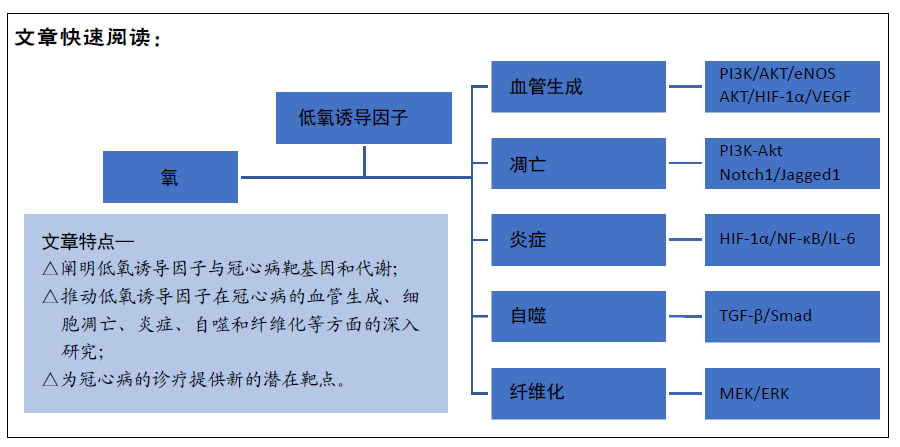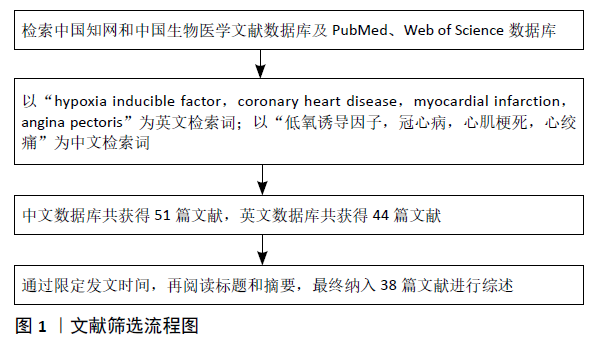[1] SEMENZA GL. Hypoxia-inducible factors in physiology and medicine. Cell. 2012;148(3):399-408.
[2] 顾霞,赵敏,王平义,等. 低氧诱导因子1α与低氧相关疾病信号通路的关系[J].中国组织工程研究,2021,25(8):1284-1289.
[3] ONG SG, LEE WH, THEODOROU L, et al. HIF-1 reduces ischaemia-reperfusion injury in the heart by targeting the mitochondrial permeability transition pore. Cardiovasc Res. 2014;104(1):24-36.
[4] LIU J, WANG S, TAN W, et al. Dual-screening of anti-inflammatory and antioxidant active ingredients of shenxiang suhe pill and its potential multi-target therapy for coronary heart disease. Biomed Pharmacother. 2020;129:110283.
[5] MA LY, CHEN WW, GAO RL, et al. China cardiovascular diseases report 2018: an updated summary. J Geriatr Cardiol. 2020;17(1):1-8.
[6] HU CJ, SATAUR A, WANG L, et al. The N-terminal transactivation domain confers target gene specificity of hypoxia-inducible factors HIF-1alpha and HIF-2alpha. Mol Biol Cell. 2007;18(11):4528-4542.
[7] BOSCH-MARCE M, OKUYAMA H, WESLEY JB, et al. Effects of aging and hypoxia-inducible factor-1 activity on angiogenic cell mobilization and recovery of perfusion after limb ischemia. Circ Res. 2007;101(12): 1310-1318.
[8] RESAR JR, ROGUIN A, VONER J, et al. Hypoxia-inducible factor 1alpha polymorphism and coronary collaterals in patients with ischemic heart disease. Chest. 2005;128(2):787-791.
[9] HLATKY MA, QUERTERMOUS T, BOOTHROYD DB, et al. Polymorphisms in hypoxia inducible factor 1 and the initial clinical presentation of coronary disease. Am Heart J. 2007;154(6):1035-1042.
[10] HUANG M, NGUYEN P, JIA F, et al. Double knockdown of prolyl hydroxylase and factor-inhibiting hypoxia-inducible factor with nonviral minicircle gene therapy enhances stem cell mobilization and angiogenesis after myocardial infarction. Circulation. 2011;124 (11 Suppl):S46-54.
[11] CZIBIK G, GRAVNING J, MARTINOV V, et al. Gene therapy with hypoxia-inducible factor 1 alpha in skeletal muscle is cardioprotective in vivo. Life Sci. 2011;88(11-12):543-550.
[12] LI X, ZHAO H, WU Y, et al. Up-regulation of hypoxia-inducible factor-1α enhanced the cardioprotective effects of ischemic postconditioning in hyperlipidemic rats. Acta Biochim Biophys Sin (Shanghai). 2014;46(2): 112-118.
[13] KRISHNAN J, SUTER M, WINDAK R, et al. Activation of a HIF1alpha-PPARgamma axis underlies the integration of glycolytic and lipid anabolic pathways in pathologic cardiac hypertrophy. Cell Metab. 2009;9(6):512-524.
[14] WEI Q, BIAN Y, YU F, et al. Chronic intermittent hypoxia induces cardiac inflammation and dysfunction in a rat obstructive sleep apnea model. J Biomed Res. 2016;30(6):490-495.
[15] PU J, ZHU S, ZHOU D, et al. Propofol Alleviates Apoptosis Induced by Chronic High Glucose Exposure via Regulation of HIF-1α in H9c2 Cells. Oxid Med Cell Longev. 2019;2019:4824035.
[16] KUMAR S, WANG G, LIU W, et al. Hypoxia-Induced Mitogenic Factor Promotes Cardiac Hypertrophy via Calcium-Dependent and Hypoxia-Inducible Factor-1α Mechanisms. Hypertension. 2018;72(2):331-342.
[17] CHENG SC, QUINTIN J, CRAMER RA, et al. mTOR- and HIF-1α-mediated aerobic glycolysis as metabolic basis for trained immunity. Science. 2014;345(6204):1250684.
[18] 王雪梅,刘芬,曹莹,等. HIF-1α介导线粒体功能调控糖尿病心肌缺血再灌注损伤的作用机制研究[J].心血管病学进展,2020,41(10): 1085-1090.
[19] SONG W, LIANG Q, CAI M, et al. HIF-1α-induced up-regulation of microRNA-126 contributes to the effectiveness of exercise training on myocardial angiogenesis in myocardial infarction rats. J Cell Mol Med. 2020;24(22):12970-12979.
[20] SUN J, SHEN H, SHAO L, et al. HIF-1α overexpression in mesenchymal stem cell-derived exosomes mediates cardioprotection in myocardial infarction by enhanced angiogenesis. Stem Cell Res Ther. 2020;11(1): 373.
[21] ORNITZ DM, MARIE PJ. Fibroblast growth factor signaling in skeletal development and disease. Genes Dev. 2015;29(14):1463-1486.
[22] YAO HC, LIU T, MENG XY, et al. Effect of basic fibroblast growth factor on the myocardial expression of hypoxia-inducible factor-1α and vascular endothelial growth factor following acute myocardial infarction. Heart Lung Circ. 2013;22(11):946-951.
[23] RAO Z, SHEN D, CHEN J, et al. Basic Fibroblast Growth Factor Attenuates Injury in Myocardial Infarction by Enhancing Hypoxia-Inducible Factor-1 Alpha Accumulation. Front Pharmacol. 2020;11:1193.
[24] LAKKISTO P, KYTÖ V, FORSTEN H, et al. Heme oxygenase-1 and carbon monoxide promote neovascularization after myocardial infarction by modulating the expression of HIF-1alpha, SDF-1alpha and VEGF-B. Eur J Pharmacol. 2010;635(1-3):156-164.
[25] CHEN Y, FU L, HAN Y, et al. Testosterone replacement therapy promotes angiogenesis after acute myocardial infarction by enhancing expression of cytokines HIF-1a, SDF-1a and VEGF. Eur J Pharmacol. 2012;684(1-3): 116-124.
[26] ORIOWO B, THIRUNAVUKKARASU M, SELVARAJU V, et al. Targeted gene deletion of prolyl hydroxylase domain protein 3 triggers angiogenesis and preserves cardiac function by stabilizing hypoxia inducible factor 1 alpha following myocardial infarction. Curr Pharm Des. 2014;20(9): 1305-1310.
[27] DU Y, GE Y, XU Z, et al. Hypoxia-Inducible Factor 1 alpha (HIF-1α)/Vascular Endothelial Growth Factor (VEGF) Pathway Participates in Angiogenesis of Myocardial Infarction in Muscone-Treated Mice: Preliminary Study. Med Sci Monit. 2018;24:8870-8877.
[28] WANG X, GUO Z, DING Z, et al. Inflammation, Autophagy, and Apoptosis After Myocardial Infarction. J Am Heart Assoc. 2018;7(9):e008024.
[29] DATTA CHAUDHURI R, BANERJEE D, BANIK A, et al. Severity and duration of hypoxic stress differentially regulates HIF-1α-mediated cardiomyocyte apoptotic signaling milieu during myocardial infarction. Arch Biochem Biophys. 2020;690:108430.
[30] SUN N, MENG F, XUE N, et al. Inducible miR-145 expression by HIF-1a protects cardiomyocytes against apoptosis via regulating SGK1 in simulated myocardial infarction hypoxic microenvironment. Cardiol J. 2018;25(2):268-278.
[31] GUVEN BAGLA A, ERCAN E, ASGUN HF, et al. Experimental acute myocardial infarction in rats: HIF-1α, caspase-3, erythropoietin and erythropoietin receptor expression and the cardioprotective effects of two different erythropoietin doses. Acta Histochem. 2013;115(7): 658-668.
[32] YU J, ZHANG X, ZHANG Y. Astragaloside attenuates myocardial injury in a rat model of acute myocardial infarction by upregulating hypoxia inducible factor‑1α and Notch1/Jagged1 signaling. Mol Med Rep. 2017;15(6):4015-4020.
[33] WANG Y, LIU J, KONG Q, et al. Cardiomyocyte-specific deficiency of HSPB1 worsens cardiac dysfunction by activating NFκB-mediated leucocyte recruitment after myocardial infarction. Cardiovasc Res. 2019;115(1):154-167.
[34] LAI XX, ZHANG N, CHEN LY, et al. Latifolin protects against myocardial infarction by alleviating myocardial inflammatory via the HIF-1α/NF-κB/IL-6 pathway. Pharm Biol. 2020;58(1):1156-1166.
[35] YU J, ZHANG L, ZHANG H. Atorvastatin combined with routine therapy on HIF-1, VEGF concentration and cardiac function in rats with acute myocardial infarction. Exp Ther Med. 2020;19(3):2053-2058.
[36] DONG F, KHALIL M, KIEDROWSKI M, et al. Critical role for leukocyte hypoxia inducible factor-1alpha expression in post-myocardial infarction left ventricular remodeling. Circ Res. 2010;106(3):601-610.
[37] WANG Z, ZHANG Z, ZHAO J, et al. Polysaccharides from Enteromorpha Prolifera Ameliorate Acute Myocardial Infarction in Vitro and in Vivo via Up-Regulating HIF-1alpha. Int Heart J. 2019;60(4):964-973.
[38] SUI X, WEI H, WANG D. Novel mechanism of cardiac protection by valsartan: synergetic roles of TGF-β1 and HIF-1α in Ang II-mediated fibrosis after myocardial infarction. J Cell Mol Med. 2015;19(8): 1773-1782. |


